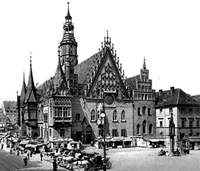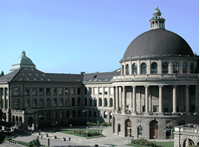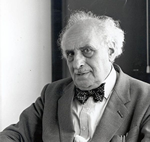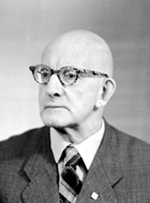 The website is in construction. New files will be uploaded as soon as they are available.
The website is in construction. New files will be uploaded as soon as they are available.
HEINZ HOPF
Gräbschen, Germany (now Grabiszyn, Wrocław, Poland) 1894 - Zollikon, Switzerland 1971
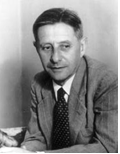
- Brief scientific biography
- Quotations relevant to mathematics education
- Primary bibliography
- Secondary bibliography
Brief scientific biography
Heinz Hopf was born on 19 November 1894 in Gräbschen, Germany (now Grabiszyn, Wrocław, Poland); from 1901 until 1904 he attended the school of Dr. Karl Mittelhaus, and until 1913 the König-Wilhelm Gymnasium in Breslau. In 1913 he entered the Silesian Friedrich Wilhelms University in Breslau to study mathematics. Hopf's teachers were Adolf Kneser (1862-1930), Erhard Schmidt (1876-1959), and Rudolf Sturm (1841-1919); he also attended lectures by Max Dehn (1878-1952) and Ernst Steinitz (1871-1928), teachers at the Polytechnic in Breslau.Breslau
His studies were interrupted by the out-break of World War I, and Hopf fought on the Western front as a lieutenant. However, in 1917, he attended a class by Schmidt on Set Theory at the University of Breslau.
After the end of the war, he returned to his studies both in Breslau and at the University of Heidelberg. In 1920 he went to study for his doctorate at the University of Berlin, where Schmidt was teaching. Hopf attended some courses by Issai Schur (1875-1941) in Berlin and received his doctorate in 1925 with a thesis, supervised by Schmidt, studying the topology of manifolds (O'CONNOR, ROBERTSON 2000).Eidgenössische Technische Hochschule (ETH), Zürich
In 1925 Hopf went to Göttingen, where he met both Emmy Noether (1882-1935) and Pavel Sergeyevich Aleksandrov (1896-1982). In 1926, Hopf's habilitation thesis presented a new proof of the fact shown by Lefschetz that for any closed manifold the sum of the indices of a generic vector field is a topological invariant, the Euler characteristic.
In 1926 Aleksandrov and Hopf were in the south of France, and in the academic year 1927-1928 they were in Princeton in the US, where they collaborated with Lefschetz, Veblen and Alexander, and planned a great work on Topology. The first volume appeared in 1935 (ALEXANDROV, HOPF 1935.Hans Freudenthal
In 1928 Hopf married Anja von Mickwitz (1891-1967). The next year he declined a job at Princeton University, and in 1930 Hans Freudenthal (1905-1990) did his thesis work (on the ends of topological groups) with Hopf at the University of Berlin. In 1931 Hopf accepted the offer to take over Hermann Weyl's position at Eidgenössische Technische Hochschule (ETH), in Zürich. After the Nazis came to power in 1933, Hopf worked in order to provide refuge in Switzerland for friends who had to left Germany. Lefschetz invited Hopf to Princeton but he refused once again. In 1943 Hopf (whose father was Jewish) applied for Swiss citizenship, which was soon granted.
After the end of World War II, both in 1946-19447 and in 1955-1956 Hopf visited the United States. He gave lectures at Princeton, at New York and at Stanford University.Pavel Alexandrov
From 1955 until 1958 Hopf was President of the International Mathematical Union, and member ex officio of the ICMI Executive Committee. He received honorary doctorates from Princeton, Freiburg, Manchester, Sorbonne (Paris), Brussels, and Lausanne University, and was awarded several important prizes, including the Gauss-Weber medal and the Lobacewskij prize (O'CONNOR, ROBERTSON 2000).
The greater part of Hopf's mathematical work was in algebraic topology, a sector where his contribution can be interpreted as a continuation of Luitzen Brouwer's work. Hopf studied homotopy classes and vector fields, and gave a formula about the integral curvature. In 1931 he defined what is now known as the "Hopf invariant" in his important work on maps between spheres of different dimensions which cannot be distinguished from an homological viewpoint. In 1939 he examined the homology of compact Lie groups in order to study some questions posed to him by Elie Cartan. Main ideas which he introduced in this investigation led him to define what is today called a "Hopf algebra" (O'CONNOR, ROBERTSON 2000).
Heinz Hopf died on 3 June 1971 in Zollikon, Switzerland. With reference to Hopf's Collected Papers (HOPF 2001), Beno Eckmann wrote:"It is indeed astonishing to realise that this oeuvre of a whole scientific life consists of only about 70 writings, Comptes Rendus Notes and survey articles included, and of course the book Topology I written jointly with Paul Aleksandrov. Astonishing also the transparent and clear style, the concreteness of the problems, and how abstract and farreaching the methods Hopf invented to master them abstract, but without unnecessary generalities".
Quotations relevant to mathematics education
Gianfranco Arrigo (Lugano, Switzerland), one of Hopf's students in Zürich, ETH, wrote (private communication, the translation is ours):"Heinz Hopf influenced me deeply and lastingly. He was my professor during the last period of his career: he was rather old, small and slim, but his mind was formidable, bright, and really lighted up all the students' minds. His lessons were unforgettable mathematical journeys. He taught us to build up our own mathematics. All his students understood him without particular difficulties, he always took care to make sure that we were able to follow his arguments: in the first part of every lesson, he used to ask us explicitly to remember all the elements needed in order to understand his ideas. He was very kind with all the students, always encouraging them to do better and better. He let us know that true mathematics is not something locked up into formulas or into books, but rather incited us to find out the mathematical ideas that we were able to construct little by little".
Primary bibliography
H. HOPF 1925, Zum Clifford-Kleinischen Raumproblem, Math. Ann., 95, 313-339
H. HOPF 1925a, Über die Curvatura integra geschlossener Hyperflächen, Math. Ann., 95, 340-367
H. HOPF 1925b, Die Curvatura integra Clifford-Kleinischen Raumformen, Nachr. D. Ges. d. Wissensch. Göttingen, Math.phys. Kl., 131-141
H. HOPF 1926, Abbildungen geschlossener Mannigfaltigkeiten auf Kugeln in n-Dimensionen, Jber. Dt. Math.Verein, 34, 130-133
H. HOPF 1926a, Abbildungklassen n-dimensionalen Mannigfaltigkeiten, Math. Ann., 96, 209-224
H. HOPF 1926b, Vektorfelder in n-dimensionalen Mannigfaltigkeiten, Math. Ann., 96, 225-250
A. BRAUER, R. BRAUER,H. HOPF 1926, Über die Irreduzibilität einiger spezieller Klassen von Polynomen, Jber. Dt. Math.-Verein, 35, 99-122
H. HOPF 1927, Über Mindestzahlen von Fixpunkten, Math. Z., 26, 762-774
H. HOPF 1928, A new proof of the Lefschetz Formula on Invariant Points, Proc. Of the Nat. Acad. of Sciences USA, 14, 149-153
H. HOPF 1928a, On Some Properties of One-Valued Transformations of Manifolds, Proc. Of the Nat. Acad. of Sci. USA, 14, 206-214
H. HOPF 1928b, Zur Topologie der Abbildungen von Mannigfaltigkeiten. Erster Teil. Neue Darstellung der Theorie des Abbildungsgrades für topologische Mannigfaltigkeiten, Math. Ann., 100, 579-608
H. HOPF 1928c, Eine Verallgemeinerung der Euler-Poincaréschen Formel, Nachr. D. Ges. d. Wissensch. Göttingen, Math.-phys. Kl., 127-136
H. HOPF 1929, Über die algebraische Anzahl von Fixpunkten, Math. Z., 29, 493-524
H. HOPF 1929a, Zur Topologie der Abbildungen von Mannigfaltigkeiten. Zweiter Teil. Klasseninvarianten von Abbildungen, Math. Ann.,102, 562-623
H. HOPF 1930, Über die Verteilung quadratischer Reste, Math. Z., 32, 222-231
H. HOPF 1930a, Zur Algebra der Abbildungen von Mannigfaltigkeiten, J. reine u. angew. Math., 163, 71-88
H. HOPF 1930b, Über wesentliche und unwesentliche Abbildungen von Komplexen, Recu. math. de Moscou, 37, 53-62
H. HOPF 1931, Über die Abbildungen der dreidimensionalen Sphäre auf die Kugelfläche, Math. Ann., 104, 637-335
H. HOPF 1931a, Beiträge zur Klassifizierung der Flächenabbildungen, J. reine u. angew. Math., 165, 225-236
H. HOPF, W. RINOW 1931, Über den Begriff der vollständigen differentialgeometrischen Fläche, Comm. Math. Helv., 3, 209-225
H. HOPF 1931, Géometrie infinitésimale et topologie, Enseign. Math., 30, 233-240
H. HOPF 1932, Differentialgeometrie und topologische Gestalt, Jber. Dt. Math.-Verein, 41, 209-229
H. HOPF, W. RINOW 1932, Die topologischen Gestalten differentialgeometrisch verwandter Flächen, Math. Ann., 107, 113-123
H. HOPF 1933, Die Klassen der Abbildungen n-dimensionalen Polyeder auf die n-dimensionalen Sphäre, Comm. Math. Helv., 5, 39-54
H. HOPF, E. PANNWITZ 1933, Über stetige Deformationen von Komplexen in sich, Math. Ann., 108, 433-465
P. ALEXANDROV, H. HOPF 1935, Topologie I, Berlin
H. HOPF 1935, Über die Abbildungen von Sphären auf Sphären niedrigerer Dimension, Fundam. Math., 25, 427-440
H. HOPF 1935a, Über die Drehung der Tangenten und Sehenen ebener Kurven, Compos. Math., 2, 50-62
H. HOPF 1936, Freie Überdeckungen und freie Abbildungen, Fundam. Math., 28, 33-57
H. HOPF 1937, Quelques problèmes de la théorie des représentations continues, Enseign. Math., 35, 334-347
P. ALEXANDROV, H. HOPF, L. PONTRJAGIN 1937, Über den Brouwerschen Dimensionsbe-griff, Compos. Math., 4, 239-255
H. HOPF 1937a, Über die Sehenen ebener Kontinuen und die Schleifen geschlossener Wege, Comm. Math. Helv., 9, 303-319
H. HOPF, H. SAMELSON 1938, Zum Beweis des Kongruenzsatzes für Eiflächen, Math. Z., 43, 749-766
H. HOPF 1938, Eine Charakterisierung der Bettischen Gruppen von Polyedern durch stetige Ab-bildungen, Compos. Math., 5, 347-353
H. HOPF, H. SCHLIT 1938, Über Isometrie und stetige Verbiegung von Flächen, Math. Ann., 116, 58-75
H. HOPF, M. RUEFF 1938/1939, Über faserungstreue Abbildungen der Sphären, Comm. Math. Helv., 11, 49-61
H. HOPF 1939, Sur la topologie des groupes clos de Lie et de leurs generalizations, C R. Paris, 208, 266-267
H. HOPF 1940, Système: symmetrischer Bilinearformen und euklidische Modelle der projektiven Räume, Vjschr. d. Naturforsch. Gesell. Zürich (Festschr. Rudolf Fueter), 85, 165-177
H. HOPF 1940/1941, Ein topologisclier Beitrag zur reellen Algebra, Comm. Math. Helv., 13, 219-239
H. HOPF, H. SAMELSON 1940/1941, Ein Satz über die Wirkungsräume geschlossener Liescher Gruppen, Comm. Math. Helv., 13, 240-251
H. HOPF 1940/1941, Über den Rang geschlossener Liescher Gruppen, Comm. Math. Helv., 13, 119-143
H. HOPF 1941, Relations between the Fundamental Group and the Second Betti Group, Lectures in Topology, Ann Arbor, Mich. 315-316
H. HOPF 1941a, Über die Topologie der Gruppen-Mannigfaltigkeiten und ihrer Verallgemeinerungen, Ann. of Math., 42, 22-52
H. HOPF 1946, Bericht über einige neue Ergebnisse in der Topologie, Rev. Mat. Hispano-Amer., 6, 147-159
H. HOPF 1941/1942, Fundamentalgruppe und zweite Bettische Gruppe, Comm. Math. Helv., 14, 257-309
H. HOPF 1942/1943, Nachtrag zu der Arbeit "Fundamentalgruppe und zweite Bettische Gruppe",Comm. Math. Helv., 15, 27-32
H. HOPF 1942/1943, Maximale Toroide und singuläre Elemente in geschlossen Lieschen Gruppe, Comm. Math. Helv., 15, 59-70
H. HOPF 1943/1944, Enden offener Räume und unendliche diskontinuierliche Gruppen, Comm. Math. Helv., 16, 81-100
H. HOPF 1944, Eine Verallgemeinerung bekannter Abbìlduns und Überdeckungssätze, Port. Math., 4, 129-139
H. HOPF 1944/1945, Über die Bettischen Gruppen, die zu einer beliebigen Gruppe gehören, Comm. Math. Helv., 17, 39-79
H. HOPF 1944/1945, Beiträge zur Homotopietheorie, Comm. Math. Helv., 17, 307-326
H. HOPF 1947, Sur les champs d'éléments de surface dans les variétés á 4 dimensions, Topologie algébrique, Paris 1947 (Colloques Internationaux CNRS Paris 1949), 55-59
H. HOPF 1948, Zur Topologie der komplexen. Mannigfaltigkeìten, Studies and Essays presented to R. Courant, New York, 167-185
H. HOPF 1950, Die n-dimensionalen Sphären und projektiven Räume in der Topologie, Proc. of the Int. Congr. of Math., Cambridge, Mass., 1, 193-202 (AMS 1952)
H. HOPF 1951, Introduction à la théorie des espaces fibrés, Colloque de Topologie (Espaces fibrés), CBRM Bruxelles 1950, Liège 1951, 9-14
H. HOPF 1951a, Sur une formule de la théorie des espaces fibrés, Colloque de Topologie (Espaces fibrés), CBRM Bruxelles 1950, Liège 1951, 117-121
H. HOPF 1951b, Über komplex-analytische Mannigfaltigkeiten, Rend. Math Univ. Roma, 10, 169-182
H. HOPF 1951c, Über Flächen mit einer Relation zwischen den Hauptkrümmungen, Math. Nachr., 4, 232-249
H. HOPF, K. VOSS 1952, Ein Satz aus den Flächentheorie im Grossen, Arch. d. Math., 3, 187-192
H. HOPF 1952, Einige Anwendungen der Topologie auf die Algebra, Rend. Mat. Univ. Torino, 11, 75-91
H. HOPF 1952a, Sulla geometria riemanniana globale delle superficie, Rend. Mat Univ. Milano, 23, 48-63
H. HOPF 1953, Über Zusammenhänge zwischen Topologie und Metrik im Rahmen der elemen-taren Geometrie, Math.Phys. Semesterber, 3, 16-29
H. HOPF 1953a, Vom Bolzanoschen Nullstellensatz zur algebraischen Homotopietheorie der Sphä-ren, Jber. Dt. Math.-Verein, 56, 59-76
H. HOPF 1954, Zur Differentialgeometrie geschlossener Flächen im euklidischen Raum, Conv. Int. di Geom. Differenziale, Roma, 4-54
H. HOPF 1957, Die Coinzidenz-Cozyklen und eine Formel aus der Fasertheorie, Algebraic Geometry and Topology, A Symposium in honor of S. Lefschetz, Princeton, 263-279
H. HOPF 1955, Schlichte Abbildungen und lokale Modifikationen 4-dimensionaler komplexer Mannigfaltigkeiten, Comm, Math. Helv., 19, 132-156
F. HIRZEBRUCH, H. HOPF 1958, Felder von Flächenelementen in 4-dimensionalen Mannigfaltigkeiten, Math. Ann., 136, 156-172
H. HOPF 1962, Über den Defekt Stetiger Abbildungen von Mannigfaltigkeiten, Rend. Mat. Univ. Roma, 21, 273-285
H. HOPF 1964, Selecta Heinz Hopf, Berlin, Springer Verlag
H. HOPF 1966, Einige Persönliche Erinnerungen aus del Vorgeschichte der heutigen Topologie, Colloque de Topologie, CBRM Bruxelles, 9-20
H. HOPF 1966a, Ein Abschnitt aus der Entwicklung der Topologie, Jber. Dt. Math.-Verein, 68, 182-192
H. HOPF, Y. KATSURADA 1968, Some congruence theorems for closed hypersurfaces in Rie-mann spaces II, Comment. Math. Helv., 43, 217-223
H. HOPF, Y. KATSURADA 1971, Some congruence theorems for closed hypersurfaces in Rie-mann spaces III, Comment. Math. Helv., 46, 478-486
H. HOPF 2001, Collected Papers, Berlin, Springer Verlag
Secondary bibliography
P. S. ALEKSANDROV 1976/1977, Heinz Hopf zum Gedenken I: Einige Erinnerungen an Heinz Hopf, Jahresberichte der Deutschen Mathematiker-Vereinigung, 78(3), 113-125
P. S. ALEKSANDROV 1977, In memory of Heinz Hopf (Russian), Uspekhi Mat. Nauk, 32(3) (195), 203-208
H. BEHNKE, F. HIRZEBRUCH 1972, In memoriam Heinz Hopf, Math. Ann., 196, 1-7
H. CARTAN 1972, Heinz Hopf (1894-1971), International Mathematical Union, 1-7
B. ECKMANN 1971, In memory of Heinz Hopf, Bol. Soc. Brasil. Mat., 2(2), 1-7
B. ECKMANN 1972, Zum Gedenken an Heinz Hopf, Enseignement Math., (2)18, 105-112
B. ECKMANN 1994, Zum 100. Geburtstag von Heinz Hopf, Elemente der Mathematik, 49(4), 133-136
G. FREI, U. STAMMBACH 1999, Heinz Hopf, in History of topology, Amsterdam, 991-1008
H. FREUDENTHAL 1970-1990, Biography in Dictionary of Scientific Biography, New York
P. J. HILTON 1972, Heinz Hopf, Bull. London Math. Soc., 4, 202-217
J. J. O'CONNOR, E. F. ROBERTSON 2000, Heinz Hopf, MacTutor History of Mathematics, http://www-history.mcs.st-andrews.ac.uk/Biographies/Hopf.html
H. SAMELSON 1976/1977, Heinz Hopf zum Gedenken II: Zum wissenschaftlichen Werk von Heinz Hopf, Jahresberichte der Deutschen Mathematiker-Vereinigung, 78(3), 126-146
K. VOSS 1973, In memoriam Heinz Hopf, Elem. Math., 28, 81-83
Author
Giorgio T. Bagni
Department of Mathematics and Computer Science
University of Udine - Italy
giorgio.bagni@dimi.uniud.it
